Roberts A.D. The Cambridge History of Africa, Volume 7: from 1905 to 1940
Подождите немного. Документ загружается.

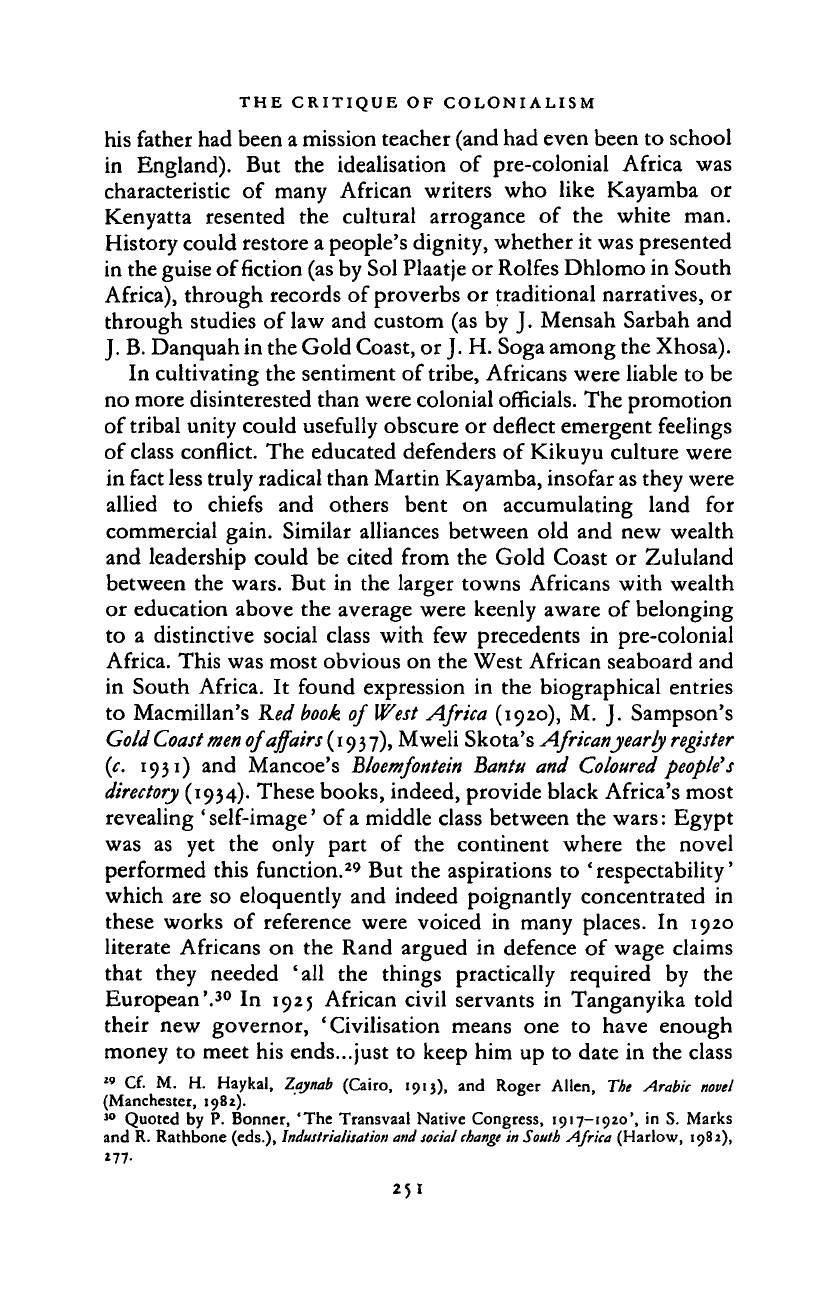
THE CRITIQUE OF COLONIALISM
his father had been a mission teacher (and had even been to school
in England).
But the
idealisation
of
pre-colonial Africa
was
characteristic
of
many African writers who like Kayamba
or
Kenyatta resented
the
cultural arrogance
of the
white
man.
History could restore a people's dignity, whether it was presented
in the guise of fiction (as by Sol Plaatje or Rolfes Dhlomo in South
Africa), through records of proverbs or traditional narratives,
or
through studies of law and custom (as by
J.
Mensah Sarbah and
J.
B.
Danquah in the Gold Coast, or J. H. Soga among the Xhosa).
In cultivating the sentiment of
tribe,
Africans were liable to be
no more disinterested than were colonial officials. The promotion
of tribal unity could usefully obscure or deflect emergent feelings
of class conflict. The educated defenders of Kikuyu culture were
in fact less truly radical than Martin Kayamba, insofar
as
they were
allied
to
chiefs
and
others bent
on
accumulating land
for
commercial gain. Similar alliances between old and new wealth
and leadership could be cited from the Gold Coast
or
Zululand
between the wars. But
in
the larger towns Africans with wealth
or education above the average were keenly aware
of
belonging
to
a
distinctive social class with few precedents
in
pre-colonial
Africa. This was most obvious on the West African seaboard and
in South Africa.
It
found expression
in
the biographical entries
to Macmillan's Red
book
of
West
Africa (1920), M.
J.
Sampson's
Gold
Coast men
of affairs (1937), Mweli Skota's African yearly
register
(c.
1931)
and
Mancoe's Bloemfontein Bantu and
Coloured
people's
directory
(1934). These books, indeed, provide black Africa's most
revealing
'
self-image' of
a
middle class between the wars: Egypt
was
as yet the
only part
of the
continent where
the
novel
performed this function.
29
But the aspirations
to
' respectability'
which are
so
eloquently and indeed poignantly concentrated
in
these works
of
reference were voiced
in
many places.
In
1920
literate Africans
on
the Rand argued
in
defence
of
wage claims
that they needed
'all the
things practically required
by the
European'.
30
In
1925 African civil servants
in
Tanganyika told
their new governor, 'Civilisation means
one to
have enough
money to meet his ends...just to keep him up to date in the class
«
Cf. M. H.
Haykal, Zaynab (Cairo, 1915),
and
Roger Allen, The Arabic novel
(Manchester, 1982).
10
Quoted by P. Bonner, 'The Transvaal Native Congress, 1917-^20',
in
S. Marks
and
R.
Rathbone (eds.), Industrialisation and
social change
in South Africa (Harlow, 1982),
*77-
251
Cambridge Histories Online © Cambridge University Press, 2008
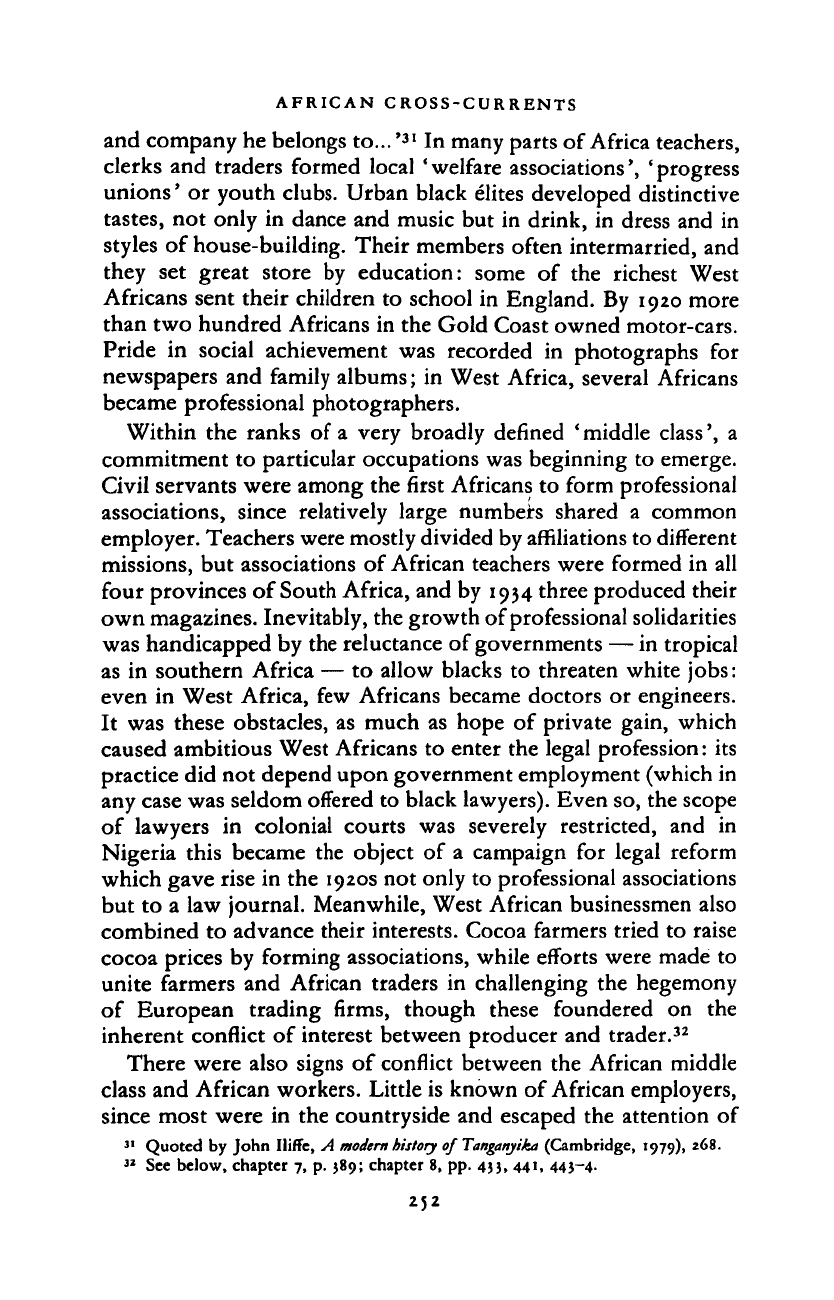
AFRICAN CROSS-CURRENTS
and company
he
belongs
to...'
31
In
many parts
of
Africa teachers,
clerks
and
traders formed local 'welfare associations', 'progress
unions'
or
youth clubs. Urban black elites developed distinctive
tastes,
not
only
in
dance
and
music
but in
drink,
in
dress
and in
styles
of
house-building. Their members often intermarried,
and
they
set
great store
by
education: some
of the
richest West
Africans sent their children
to
school
in
England.
By
1920 more
than two hundred Africans
in the
Gold Coast owned motor-cars.
Pride
in
social achievement
was
recorded
in
photographs
for
newspapers
and
family albums;
in
West Africa, several Africans
became professional photographers.
Within
the
ranks
of a
very broadly defined 'middle class',
a
commitment
to
particular occupations was beginning
to
emerge.
Civil servants were among the first Africans
to
form professional
associations, since relatively large numbers shared
a
common
employer. Teachers were mostly divided by affiliations to different
missions,
but
associations
of
African teachers were formed
in all
four provinces
of
South Africa, and
by
1934 three produced their
own magazines. Inevitably, the growth of professional solidarities
was handicapped
by
the reluctance
of
governments
—
in tropical
as
in
southern Africa —
to
allow blacks
to
threaten white jobs:
even
in
West Africa,
few
Africans became doctors
or
engineers.
It
was
these obstacles,
as
much
as
hope
of
private gain, which
caused ambitious West Africans
to
enter
the
legal profession:
its
practice did
not
depend upon government employment (which
in
any case was seldom offered
to
black lawyers). Even so, the scope
of lawyers
in
colonial courts
was
severely restricted,
and in
Nigeria this became
the
object
of a
campaign
for
legal reform
which gave rise
in the
1920s
not
only
to
professional associations
but
to a law
journal. Meanwhile, West African businessmen also
combined
to
advance their interests. Cocoa farmers tried
to
raise
cocoa prices
by
forming associations, while efforts were made
to
unite farmers
and
African traders
in
challenging
the
hegemony
of European trading firms, though these foundered
on the
inherent conflict
of
interest between producer
and
trader.
32
There were also signs
of
conflict between
the
African middle
class
and
African workers. Little
is
known
of
African employers,
since most were
in
the countryside
and
escaped
the
attention
of
31
Quoted
by
John
Iliffc,
A
modern history
of
Tanganyika
(Cambridge,
1979),
268.
" See
below,
chapter
7, p.
589;
chapter
8,
pp. 433, 441,
443-4.
252
Cambridge Histories Online © Cambridge University Press, 2008
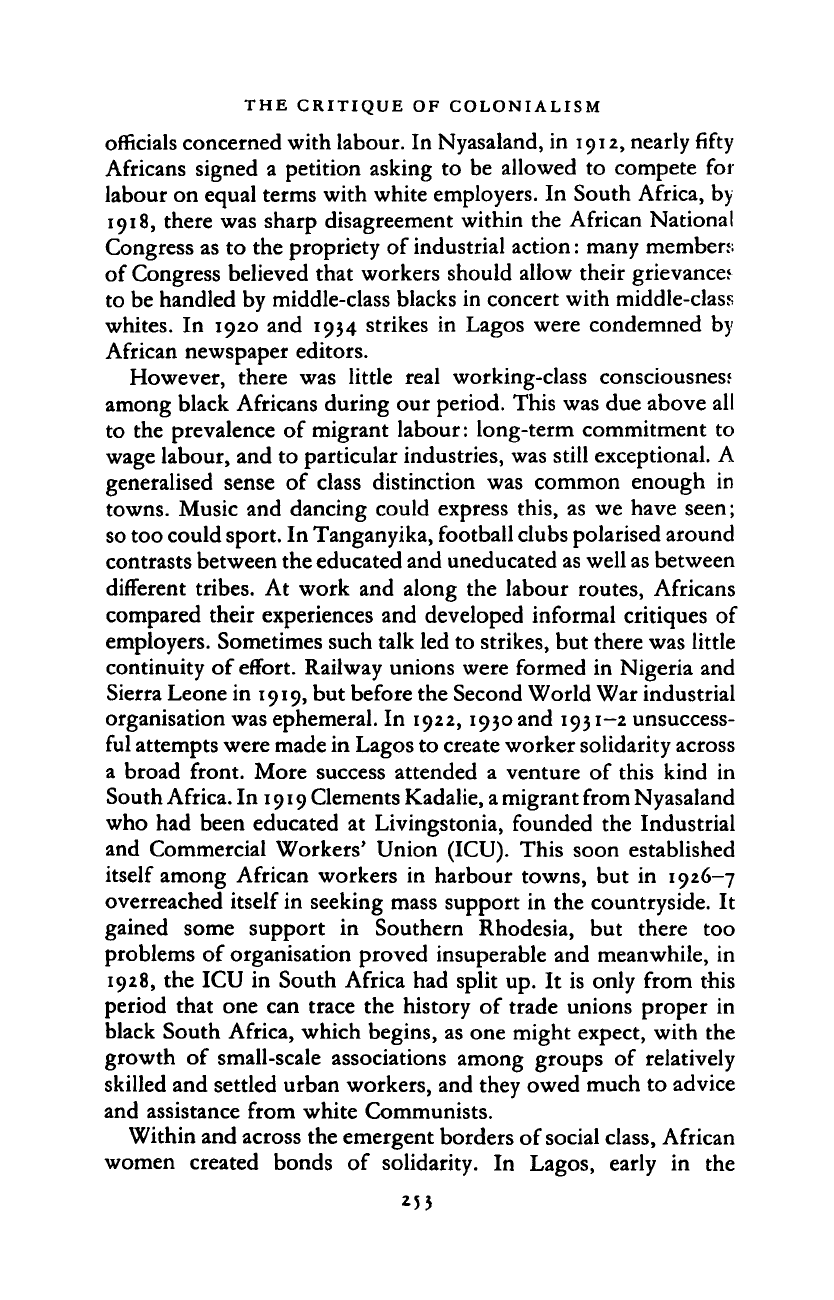
THE CRITIQUE OF COLONIALISM
officials concerned with labour. In Nyasaland, in 1912, nearly fifty
Africans signed
a
petition asking to be allowed to compete
for
labour on equal terms with white employers. In South Africa, by
1918,
there was sharp disagreement within the African National
Congress as to the propriety of industrial action: many members
of Congress believed that workers should allow their grievance}
to be handled by middle-class blacks in concert with middle-class
whites.
In
1920 and 1934 strikes
in
Lagos were condemned by
African newspaper editors.
However, there was little real working-class consciousnesf
among black Africans during our period. This was due above all
to the prevalence of migrant labour: long-term commitment
to
wage labour, and to particular industries, was still exceptional. A
generalised sense
of
class distinction was common enough
in
towns. Music and dancing could express this, as we have seen;
so too could sport. In Tanganyika, football clubs polarised around
contrasts between the educated and uneducated as well as between
different tribes. At work and along the labour routes, Africans
compared their experiences and developed informal critiques of
employers. Sometimes such talk led to strikes, but there was little
continuity of effort. Railway unions were formed in Nigeria and
Sierra Leone in 1919, but before the Second World War industrial
organisation was ephemeral. In 1922, 1930 and 1931-2 unsuccess-
ful attempts were made in Lagos to create worker solidarity across
a broad front. More success attended
a
venture
of
this kind
in
South Africa. In
1919
Clements Kadalie,
a
migrant from Nyasaland
who had been educated
at
Livingstonia, founded the Industrial
and Commercial Workers' Union (ICU). This soon established
itself among African workers
in
harbour towns, but
in
1926-7
overreached itself in seeking mass support in the countryside.
It
gained some support
in
Southern Rhodesia,
but
there
too
problems of organisation proved insuperable and meanwhile, in
1928,
the ICU in South Africa had split up.
It
is only from this
period that one can trace the history
of
trade unions proper in
black South Africa, which begins, as one might expect, with the
growth
of
small-scale associations among groups
of
relatively
skilled and settled urban workers, and they owed much to advice
and assistance from white Communists.
Within and across the emergent borders of social class, African
women created bonds
of
solidarity.
In
Lagos, early
in the
253
Cambridge Histories Online © Cambridge University Press, 2008
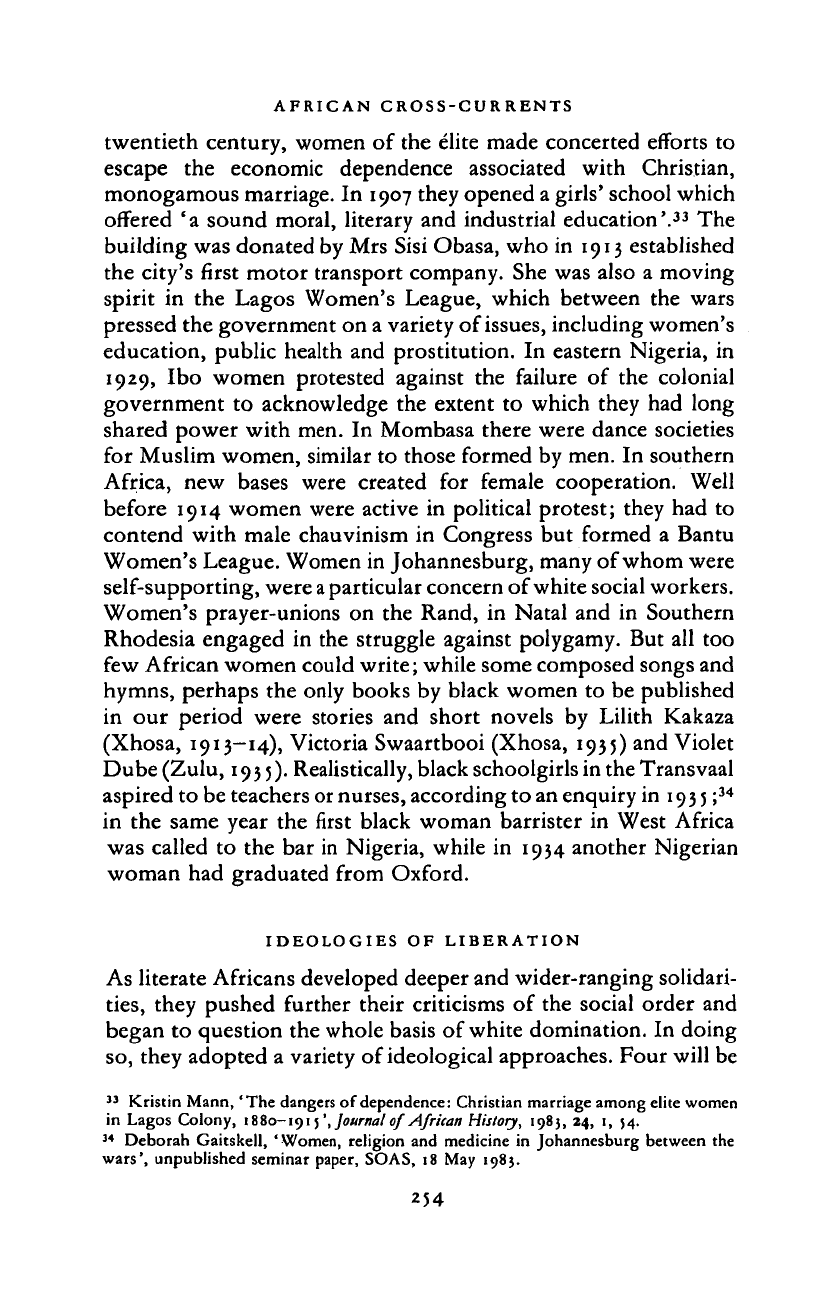
AFRICAN CROSS-CURRENTS
twentieth century, women of the elite made concerted efforts
to
escape
the
economic dependence associated with Christian,
monogamous marriage. In 1907 they opened a girls' school which
offered
'a
sound moral, literary and industrial education'.
33
The
building was donated by Mrs Sisi Obasa, who in 1913 established
the city's first motor transport company. She was also a moving
spirit
in
the Lagos Women's League, which between the wars
pressed the government on a variety of issues, including women's
education, public health and prostitution. In eastern Nigeria, in
1929,
Ibo women protested against the failure
of
the colonial
government to acknowledge the extent to which they had long
shared power with men. In Mombasa there were dance societies
for Muslim women, similar to those formed by men. In southern
Africa, new bases were created
for
female cooperation. Well
before 1914 women were active in political protest; they had
to
contend with male chauvinism in Congress but formed
a
Bantu
Women's League. Women in Johannesburg, many of whom were
self-supporting, were
a
particular concern of white social workers.
Women's prayer-unions on the Rand, in Natal and in Southern
Rhodesia engaged in the struggle against polygamy. But all too
few African women could write; while some composed songs and
hymns, perhaps the only books by black women to be published
in our period were stories and short novels
by
Lilith Kakaza
(Xhosa, 1913-14), Victoria Swaartbooi (Xhosa, 1935) and Violet
Dube (Zulu, 1935). Realistically, black schoolgirls in the Transvaal
aspired to be teachers or
nurses,
according to an enquiry in
193 5
;
34
in the same year the first black woman barrister in West Africa
was called to the bar in Nigeria, while in 1934 another Nigerian
woman had graduated from Oxford.
IDEOLOGIES OF LIBERATION
As literate Africans developed deeper and wider-ranging solidari-
ties,
they pushed further their criticisms of the social order and
began to question the whole basis of white domination. In doing
so,
they adopted a variety of ideological approaches. Four will be
33
Kristin Mann, 'The dangers of dependence: Christian marriage among elite women
in Lagos Colony, 1880-1915'', Journal of African History, 1983, 24,
1,
54.
34
Deborah Gaitskell, 'Women, religion and medicine
in
Johannesburg between the
wars',
unpublished seminar paper, SOAS, 18 May 1983.
254
Cambridge Histories Online © Cambridge University Press, 2008
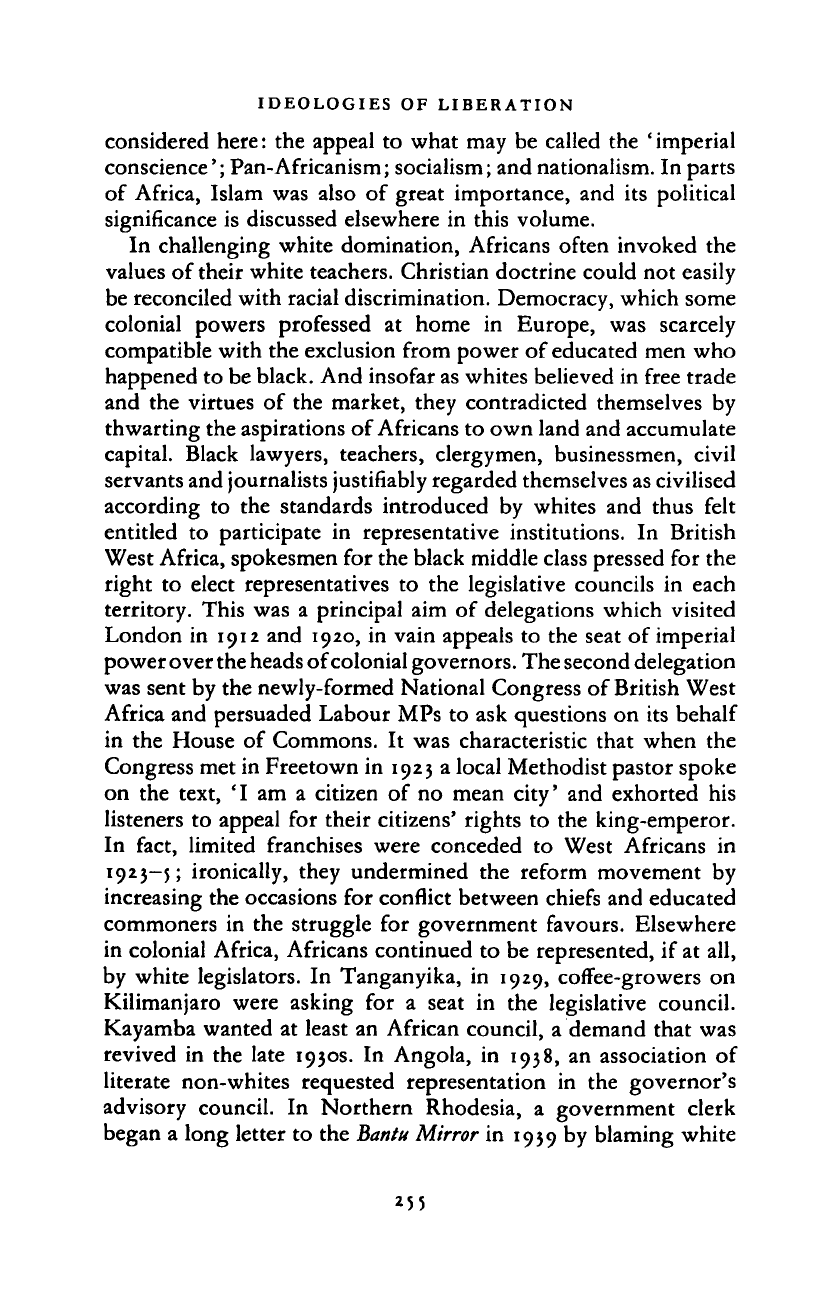
IDEOLOGIES OF LIBERATION
considered here: the appeal to what may be called the ' imperial
conscience'; Pan-Africanism; socialism; and nationalism. In parts
of Africa, Islam was also of great importance, and its political
significance is discussed elsewhere in this volume.
In challenging white domination, Africans often invoked the
values of their white teachers. Christian doctrine could not easily
be reconciled with racial discrimination. Democracy, which some
colonial powers professed at home in Europe, was scarcely
compatible with the exclusion from power of educated men who
happened to be black. And insofar as whites believed in free trade
and the virtues of the market, they contradicted themselves by
thwarting the aspirations of Africans to own land and accumulate
capital. Black lawyers, teachers, clergymen, businessmen, civil
servants and journalists justifiably regarded themselves as civilised
according to the standards introduced by whites and thus felt
entitled to participate in representative institutions. In British
West Africa, spokesmen for the black middle class pressed for the
right to elect representatives to the legislative councils in each
territory. This was a principal aim of delegations which visited
London in 1912 and 1920, in vain appeals to the seat of imperial
power over the
heads
of colonial governors. The second delegation
was sent by the newly-formed National Congress of British West
Africa and persuaded Labour MPs to ask questions on its behalf
in the House of Commons. It was characteristic that when the
Congress met in Freetown in 1923 a local Methodist pastor spoke
on the text, 'I am a citizen of no mean city' and exhorted his
listeners to appeal for their citizens' rights to the king-emperor.
In fact, limited franchises were conceded to West Africans in
1923-5;
ironically, they undermined the reform movement by
increasing the occasions for conflict between chiefs and educated
commoners in the struggle for government favours. Elsewhere
in colonial Africa, Africans continued to be represented, if at all,
by white legislators. In Tanganyika, in 1929, coffee-growers on
Kilimanjaro were asking for a seat in the legislative council.
Kayamba wanted at least an African council, a demand that was
revived in the late 1930s. In Angola, in 1938, an association of
literate non-whites requested representation in the governor's
advisory council. In Northern Rhodesia, a government clerk
began a long letter to the
Bantu
Mirror in 1939 by blaming white
255
Cambridge Histories Online © Cambridge University Press, 2008
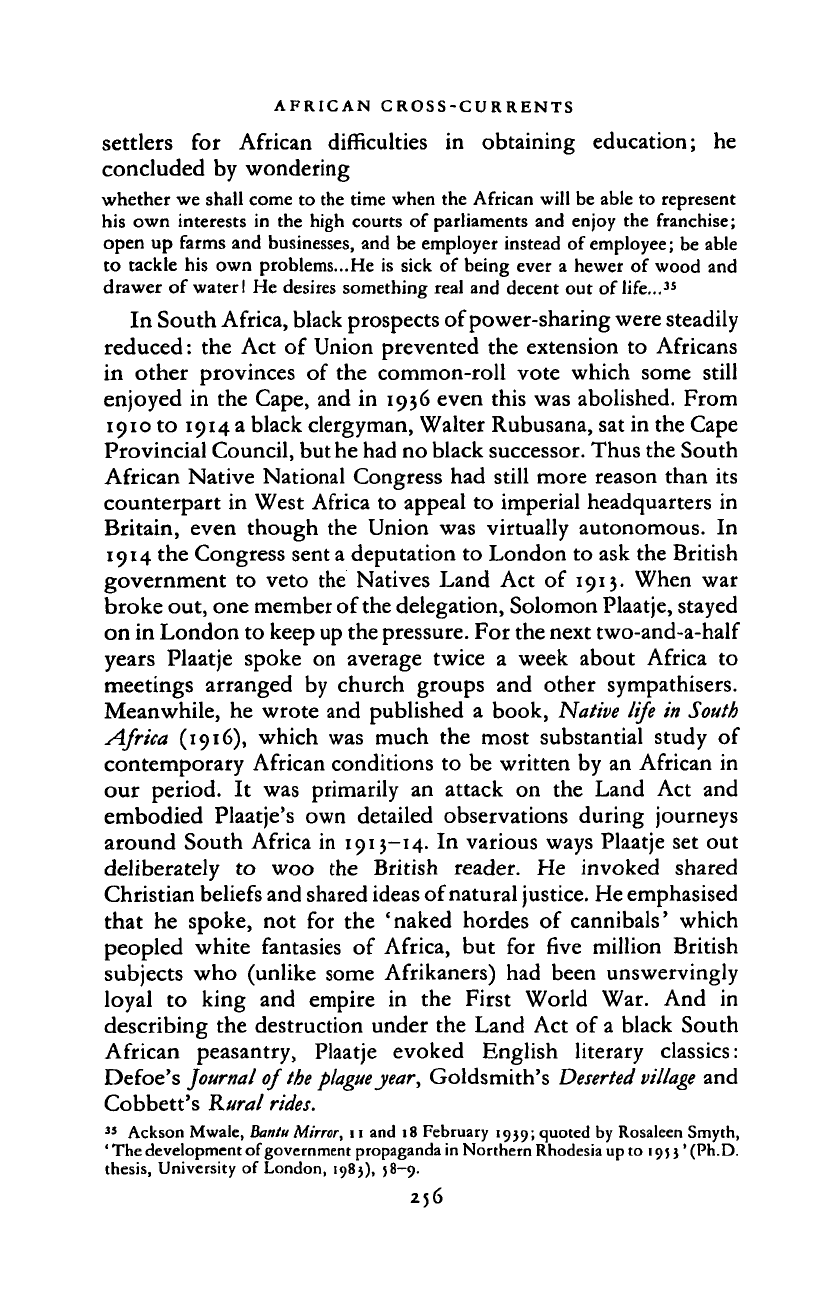
AFRICAN CROSS-CURRENTS
settlers
for
African difficulties
in
obtaining education;
he
concluded
by
wondering
whether we shall come
to
the time when the African will be able
to
represent
his
own
interests
in the
high courts
of
parliaments
and
enjoy
the
franchise;
open
up
farms and businesses, and
be
employer instead
of
employee;
be
able
to tackle
his own
problems...He
is
sick
of
being ever
a
hewer
of
wood
and
drawer
of
water! He desires something real and decent out
of
life...
35
In South Africa, black prospects of power-sharing were steadily
reduced:
the Act of
Union prevented
the
extension
to
Africans
in other provinces
of
the common-roll vote which some still
enjoyed
in
the Cape, and
in
1936 even this was abolished. From
1910 to 1914a black clergyman, Walter Rubusana, sat in the Cape
Provincial Council, but he had no black successor. Thus the South
African Native National Congress
had
still more reason than
its
counterpart
in
West Africa
to
appeal
to
imperial headquarters
in
Britain, even though
the
Union
was
virtually autonomous.
In
1914 the Congress sent a deputation
to
London
to
ask the British
government
to
veto
the
Natives Land
Act of
1913. When
war
broke out, one member of the delegation, Solomon Plaatje, stayed
on in London to keep up the pressure. For the next two-and-a-half
years Plaatje spoke
on
average twice
a
week about Africa
to
meetings arranged
by
church groups
and
other sympathisers.
Meanwhile,
he
wrote and published
a
book, Native life in South
Africa (1916), which
was
much
the
most substantial study
of
contemporary African conditions
to be
written by
an
African
in
our period.
It was
primarily
an
attack
on the
Land
Act and
embodied Plaatje's
own
detailed observations during journeys
around South Africa
in
1913-14.
In
various ways Plaatje
set out
deliberately
to woo the
British reader.
He
invoked shared
Christian beliefs and shared ideas of natural justice. He emphasised
that
he
spoke,
not for the
'naked hordes
of
cannibals' which
peopled white fantasies
of
Africa,
but for
five million British
subjects
who
(unlike some Afrikaners)
had
been unswervingly
loyal
to
king
and
empire
in the
First World
War. And in
describing the destruction under the Land Act
of
a black South
African peasantry, Plaatje evoked English literary classics:
Defoe's Journal
of
the
plague year, Goldsmith's
Deserted village
and
Cobbett's Rural rides.
35
Ackson Mwale,
bantu
Mirror,
11 and 18 February 1939; quoted by Rosaleen Smyth,
'
The development of government propaganda in Northern Rhodesia up to
195 3 '
(Ph.D.
thesis,
University
of
London, 1983), 58-9.
256
Cambridge Histories Online © Cambridge University Press, 2008
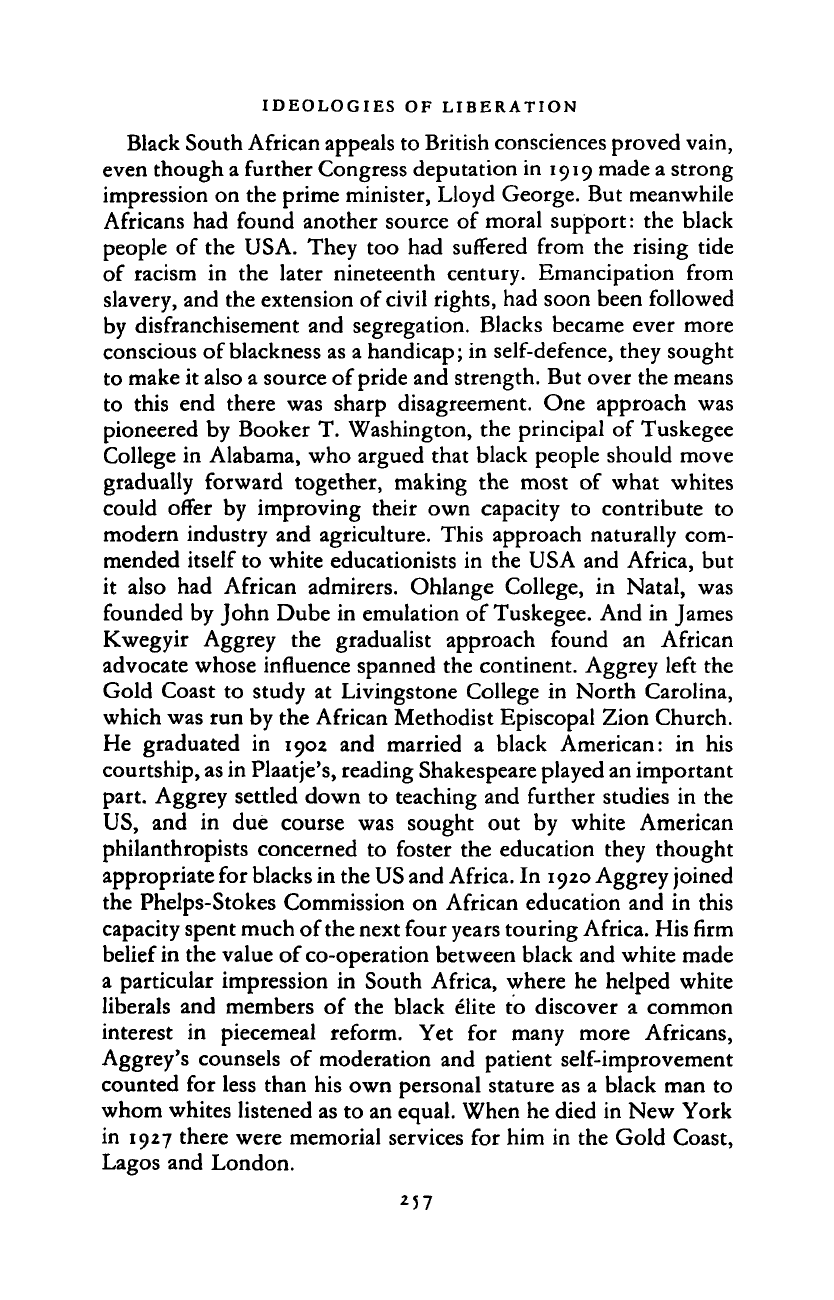
IDEOLOGIES OF LIBERATION
Black South African appeals to British consciences proved vain,
even though a further Congress deputation in 1919 made a strong
impression on the prime minister, Lloyd George. But meanwhile
Africans had found another source of moral support: the black
people of the USA. They too had suffered from the rising tide
of racism in the later nineteenth century. Emancipation from
slavery, and the extension of civil rights, had soon been followed
by disfranchisement and segregation. Blacks became ever more
conscious of blackness as a handicap; in self-defence, they sought
to make it also a source of pride and strength. But over the means
to this end there was sharp disagreement. One approach was
pioneered by Booker T. Washington, the principal of Tuskegee
College in Alabama, who argued that black people should move
gradually forward together, making the most of what whites
could offer by improving their own capacity to contribute to
modern industry and agriculture. This approach naturally com-
mended itself to white educationists in the USA and Africa, but
it also had African admirers. Ohlange College, in Natal, was
founded by John Dube in emulation of Tuskegee. And in James
Kwegyir Aggrey the gradualist approach found an African
advocate whose influence spanned the continent. Aggrey left the
Gold Coast to study at Livingstone College in North Carolina,
which was run by the African Methodist Episcopal Zion Church.
He graduated in 1902 and married a black American: in his
courtship, as in Plaatje's, reading Shakespeare played an important
part. Aggrey settled down to teaching and further studies in the
US,
and in due course was sought out by white American
philanthropists concerned to foster the education they thought
appropriate for blacks in the
US
and Africa. In
1920
Aggrey joined
the Phelps-Stokes Commission on African education and in this
capacity spent much of the next four years touring Africa. His firm
belief in the value of co-operation between black and white made
a particular impression in South Africa, where he helped white
liberals and members of the black elite to discover a common
interest in piecemeal reform. Yet for many more Africans,
Aggrey's counsels of moderation and patient self-improvement
counted for less than his own personal stature as a black man to
whom whites listened as to an equal. When he died in New York
in 1927 there were memorial services for him in the Gold Coast,
Lagos and London.
257
Cambridge Histories Online © Cambridge University Press, 2008
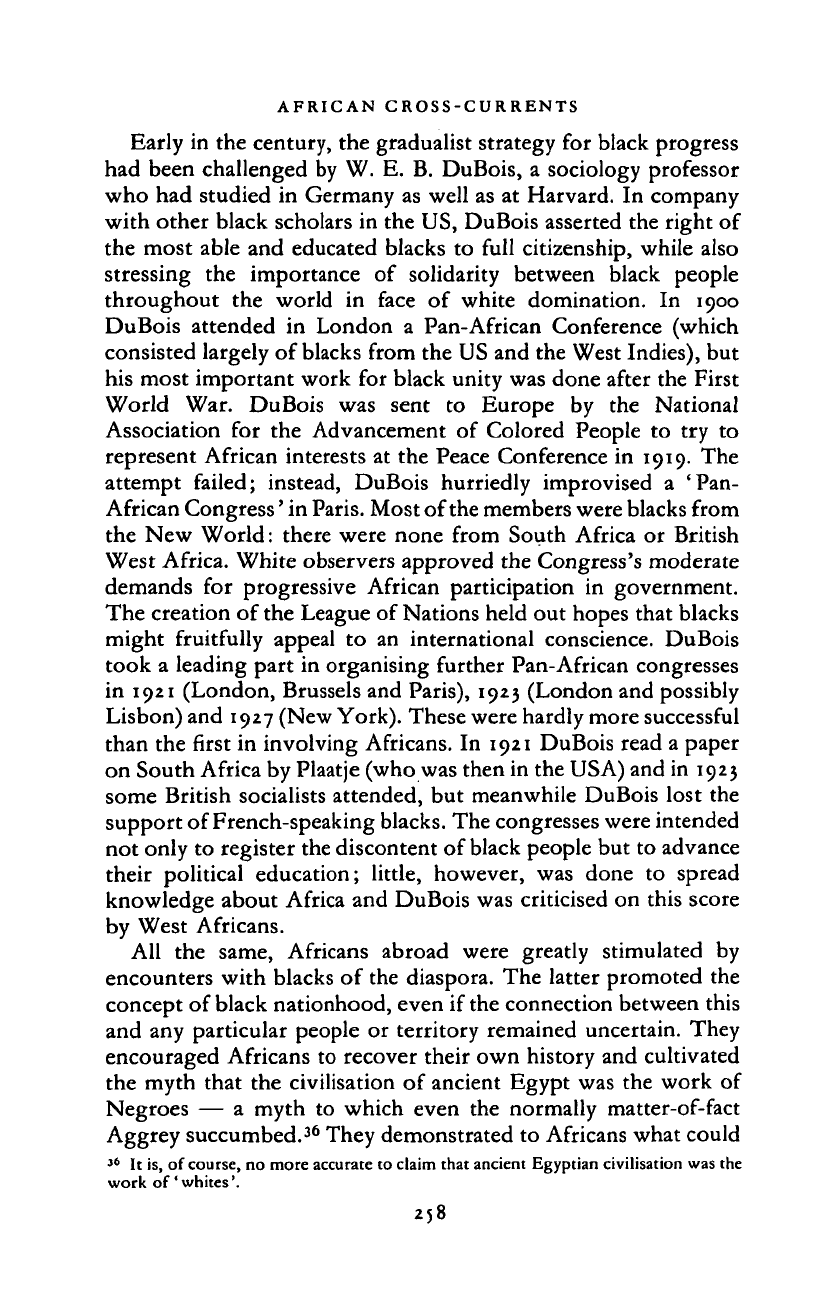
AFRICAN CROSS-CURRENTS
Early in the century, the gradualist strategy for black progress
had been challenged by W.
E.
B. DuBois,
a
sociology professor
who had studied
in
Germany as well as
at
Harvard. In company
with other black scholars in the US, DuBois asserted the right of
the most able and educated blacks
to
full citizenship, while also
stressing
the
importance
of
solidarity between black people
throughout
the
world
in
face
of
white domination.
In 1900
DuBois attended
in
London
a
Pan-African Conference (which
consisted largely of blacks from the US and the West Indies), but
his most important work for black unity was done after the First
World
War.
DuBois
was
sent
to
Europe
by the
National
Association
for the
Advancement
of
Colored People
to try to
represent African interests
at
the Peace Conference in 1919. The
attempt failed; instead, DuBois hurriedly improvised
a
'Pan-
African Congress' in
Paris.
Most of the members were blacks from
the New World: there were none from South Africa
or
British
West Africa. White observers approved the Congress's moderate
demands
for
progressive African participation
in
government.
The creation of the League of Nations held out hopes that blacks
might fruitfully appeal
to an
international conscience. DuBois
took
a
leading part in organising further Pan-African congresses
in 1921 (London, Brussels and Paris), 1923 (London and possibly
Lisbon) and 1927 (New York). These were hardly more successful
than the first in involving Africans.
In
1921 DuBois read a paper
on South Africa by Plaatje (who was then in the USA) and in 1923
some British socialists attended, but meanwhile DuBois lost the
support of French-speaking blacks. The congresses were intended
not only to register the discontent of black people but to advance
their political education; little, however,
was
done
to
spread
knowledge about Africa and DuBois was criticised on this score
by West Africans.
All
the
same, Africans abroad were greatly stimulated
by
encounters with blacks
of
the diaspora. The latter promoted the
concept of black nationhood, even if the connection between this
and any particular people
or
territory remained uncertain. They
encouraged Africans to recover their own history and cultivated
the myth that the civilisation
of
ancient Egypt was the work of
Negroes
— a
myth
to
which even the normally matter-of-fact
Aggrey succumbed.
36
They demonstrated to Africans what could
36
It
is, of course, no more accurate to claim that ancient Egyptian civilisation was the
work of'whites'.
258
Cambridge Histories Online © Cambridge University Press, 2008
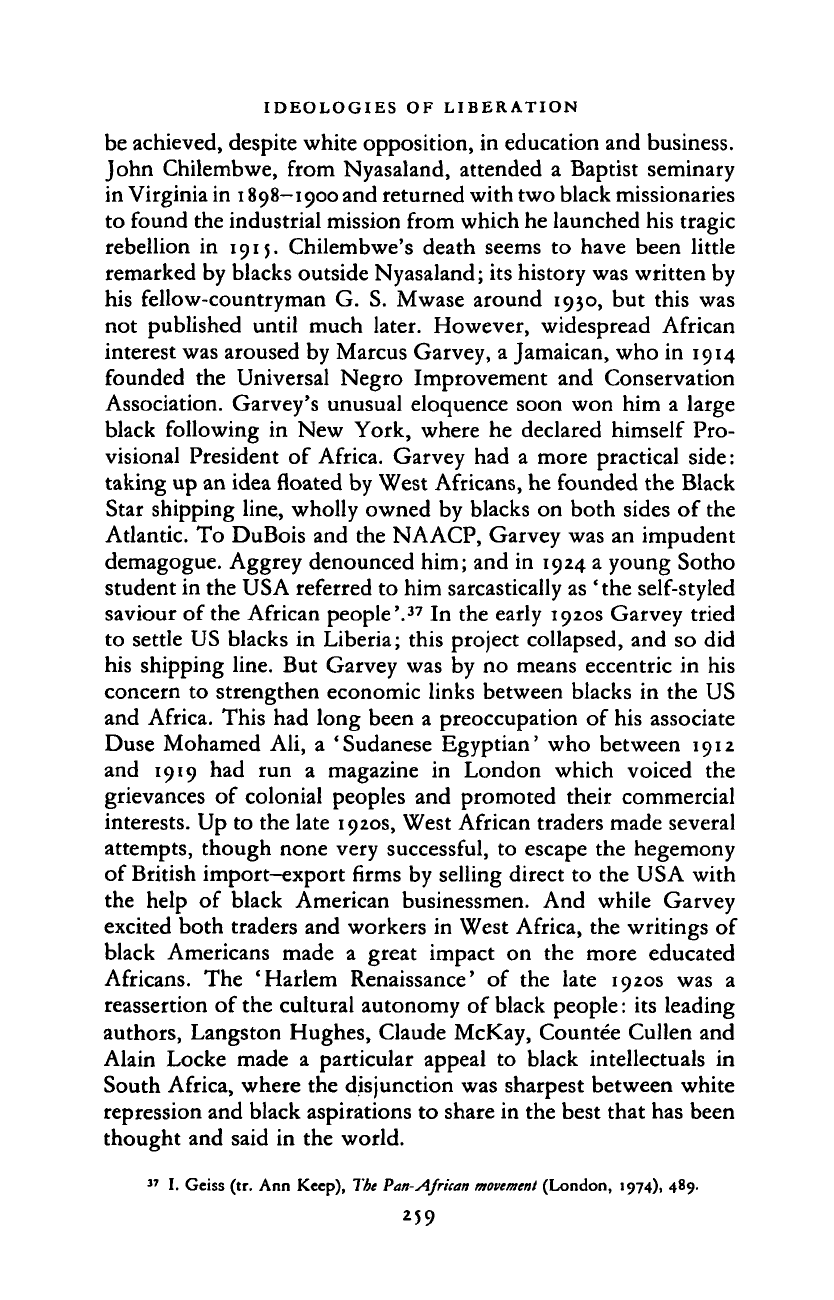
IDEOLOGIES OF LIBERATION
be achieved, despite white opposition, in education and business.
John Chilembwe, from Nyasaland, attended a Baptist seminary
in Virginia in 1898-1900 and returned with two black missionaries
to found the industrial mission from which he launched his tragic
rebellion in 1915. Chilembwe's death seems to have been little
remarked by blacks outside Nyasaland; its history was written by
his fellow-countryman G. S. Mwase around 1930, but this was
not published until much later. However, widespread African
interest was aroused by Marcus Garvey, a Jamaican, who in 1914
founded the Universal Negro Improvement and Conservation
Association. Garvey's unusual eloquence soon won him a large
black following in New York, where he declared himself Pro-
visional President of Africa. Garvey had a more practical side:
taking up an idea floated by West Africans, he founded the Black
Star shipping line, wholly owned by blacks on both sides of the
Atlantic. To DuBois and the NAACP, Garvey was an impudent
demagogue. Aggrey denounced him; and in 1924 a young Sotho
student in the USA referred to him sarcastically as ' the self-styled
saviour of the African people'.
37
In the early 1920s Garvey tried
to settle US blacks in Liberia; this project collapsed, and so did
his shipping line. But Garvey was by no means eccentric in his
concern to strengthen economic links between blacks in the US
and Africa. This had long been a preoccupation of his associate
Duse Mohamed Ali, a 'Sudanese Egyptian' who between 1912
and 1919 had run a magazine in London which voiced the
grievances of colonial peoples and promoted their commercial
interests. Up to the late 1920s, West African traders made several
attempts, though none very successful, to escape the hegemony
of British import-export firms by selling direct to the USA with
the help of black American businessmen. And while Garvey
excited both traders and workers in West Africa, the writings of
black Americans made a great impact on the more educated
Africans. The 'Harlem Renaissance' of the late 1920s was a
reassertion of the cultural autonomy of black people: its leading
authors, Langston Hughes, Claude McKay, Countee Cullen and
Alain Locke made a particular appeal to black intellectuals in
South Africa, where the disjunction was sharpest between white
repression and black aspirations to share in the best that has been
thought and said in the world.
37
I. Geiss (tr. Ann Keep), The Pan-African
movement
(London, 1974), 489.
259
Cambridge Histories Online © Cambridge University Press, 2008
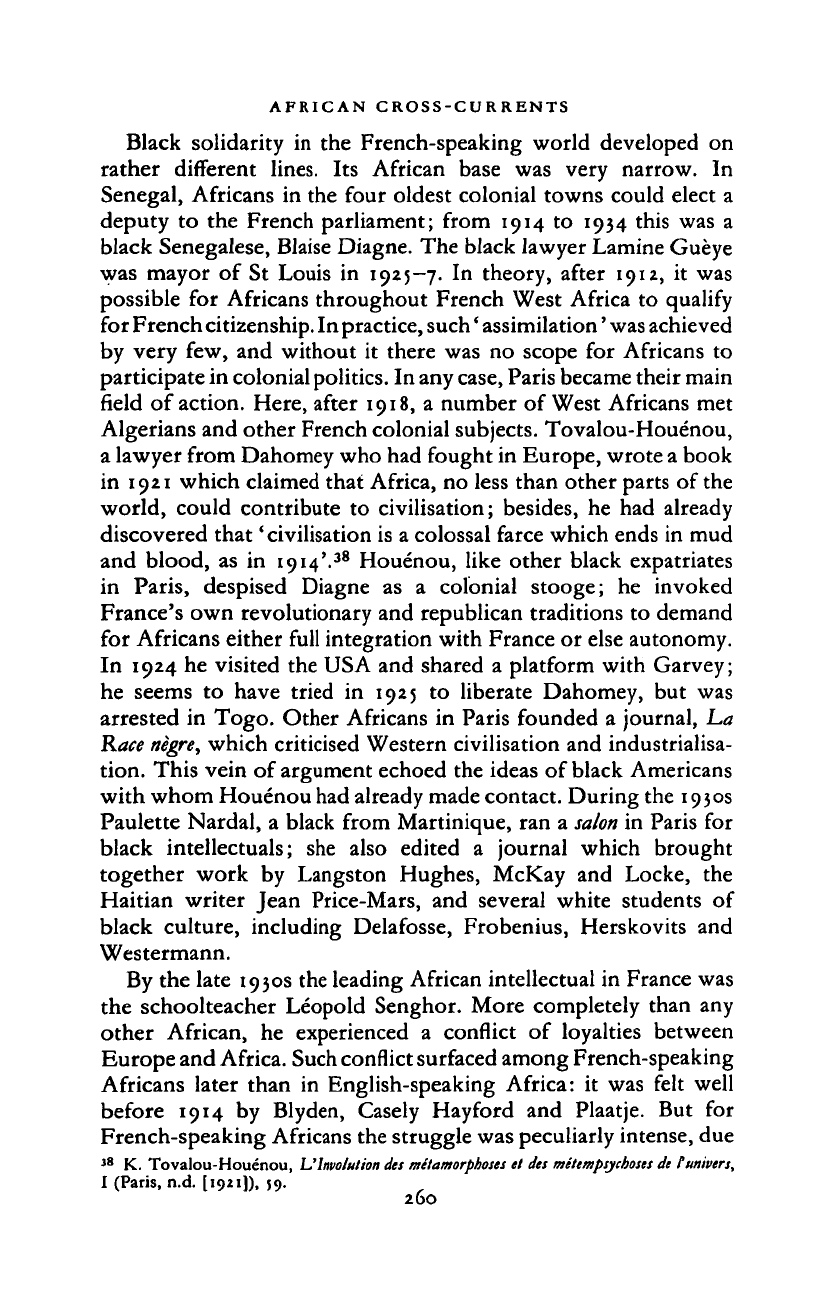
AFRICAN CROSS-CURRENTS
Black solidarity
in
the
French-speaking world developed
on
rather different lines.
Its
African base
was
very narrow.
In
Senegal, Africans
in
the four oldest colonial towns could elect
a
deputy
to
the
French parliament; from 1914
to
1934 this
was
a
black Senegalese, Blaise Diagne. The black lawyer Lamine Gueye
was mayor
of
St
Louis
in
1925-7.
In
theory, after 1912,
it
was
possible
for
Africans throughout French West Africa
to
qualify
for French
citizenship.
In
practice,
such' assimilation'
was
achieved
by very
few, and
without
it
there
was no
scope
for
Africans
to
participate in colonial
politics.
In any
case,
Paris became their main
field of action. Here, after 1918,
a
number
of
West Africans
met
Algerians and other French colonial subjects. Tovalou-Houenou,
a lawyer from Dahomey who had fought in Europe, wrote
a
book
in 1921 which claimed that Africa,
no
less than other parts
of
the
world, could contribute
to
civilisation; besides,
he
had
already
discovered that' civilisation is a colossal farce which ends
in
mud
and blood,
as in
1914'.
38
Houenou, like other black expatriates
in Paris, despised Diagne
as a
colonial stooge;
he
invoked
France's own revolutionary and republican traditions
to
demand
for Africans either full integration with France
or
else autonomy.
In 1924
he
visited
the
USA
and
shared
a
platform with Garvey;
he seems
to
have tried
in
1925
to
liberate Dahomey,
but
was
arrested
in
Togo. Other Africans
in
Paris founded
a
journal,
La
Race
negre,
which criticised Western civilisation
and
industrialisa-
tion. This vein
of
argument echoed
the
ideas
of
black Americans
with whom Houenou had already made contact. During the 1930s
Paulette Nardal,
a
black from Martinique,
ran a
salon
in
Paris
for
black intellectuals;
she
also edited
a
journal which brought
together work
by
Langston Hughes, McKay
and
Locke,
the
Haitian writer Jean Price-Mars,
and
several white students
of
black culture, including Delafosse, Frobenius, Herskovits
and
Westermann.
By
the
late 1930s the leading African intellectual
in
France was
the schoolteacher Leopold Senghor. More completely than
any
other African,
he
experienced
a
conflict
of
loyalties between
Europe and Africa.
Such
conflict surfaced among French-speaking
Africans later than
in
English-speaking Africa:
it
was
felt well
before
1914
by
Blyden, Casely Hayford
and
Plaatje.
But for
French-speaking Africans the struggle was peculiarly intense, due
38
K.
Tovalou-Houenou,
L
J
Involution
des
metamorphoses
el
des
metempsychoses
de tunivers,
I (Paris,
n.d.
[1921]),
59-
260
Cambridge Histories Online © Cambridge University Press, 2008
